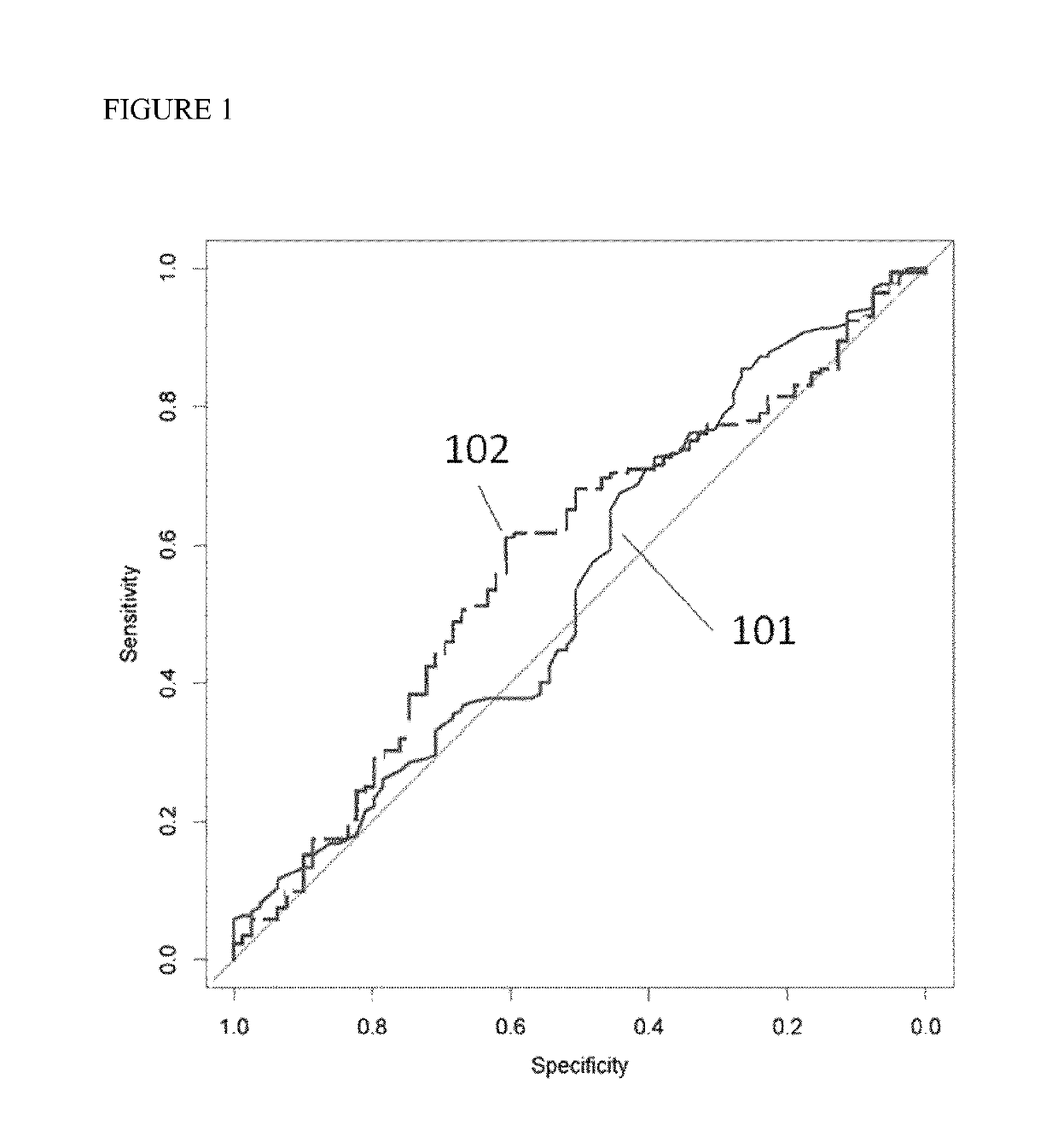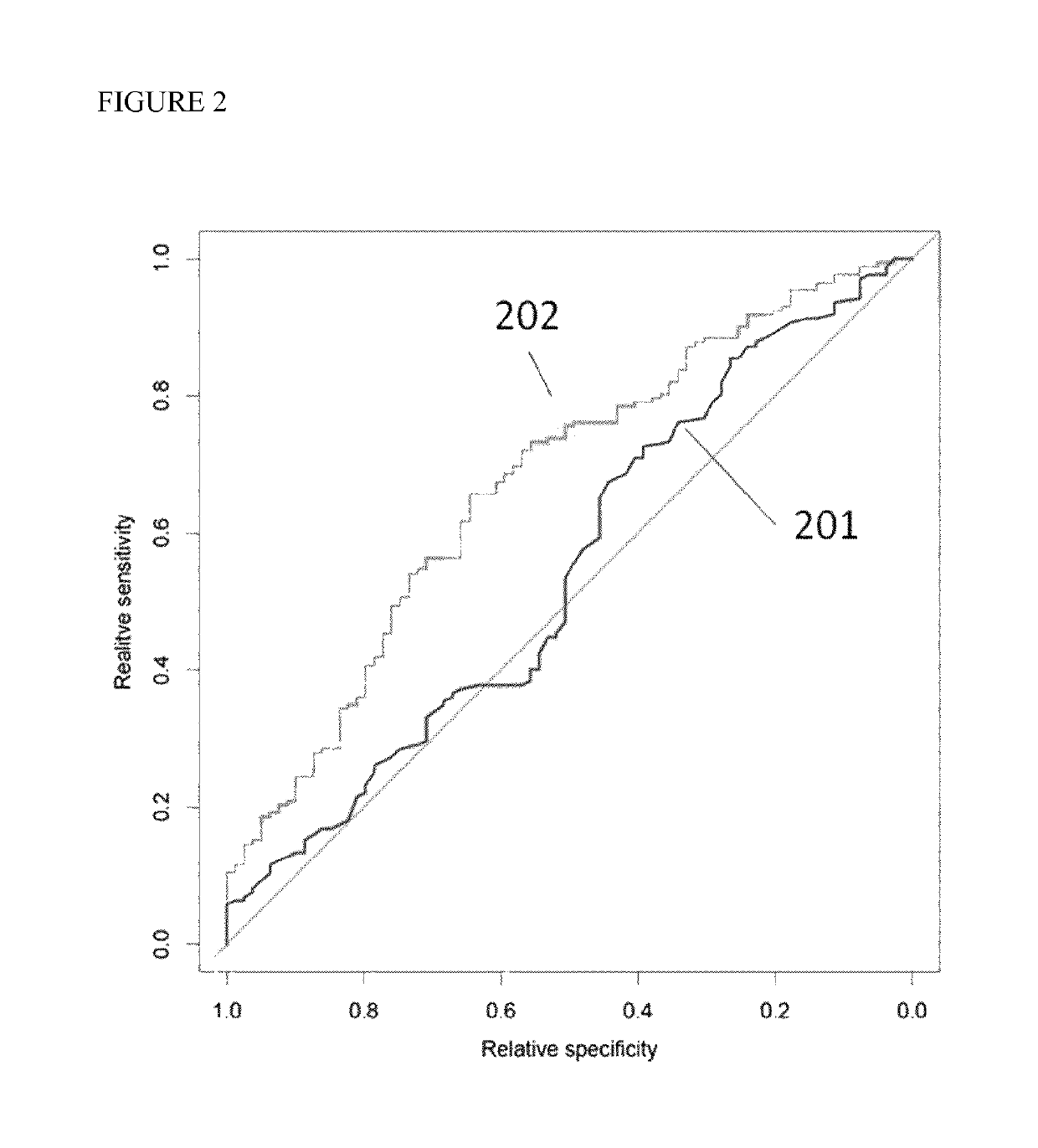Prognostic method for individuals with prostate cancer
a prostate cancer and prognosis technology, applied in the field of prognostic methods for individuals with prostate cancer, can solve the problems of incontinence and gastrointestinal problems, advanced therapy has a number of serious side effects, and the prognosis is difficult to be determined, so as to improve the ability to determine and be easily treated.
- Summary
- Abstract
- Description
- Claims
- Application Information
AI Technical Summary
Benefits of technology
Problems solved by technology
Method used
Image
Examples
example 1
[0159]To illustrate the current invention, a data set comprising 172 cases (subjects known to suffer from PCa that received active treatment) and 79 controls (subjects known to suffer from PCa where watchful waiting was decided) from the STHLM2 data set was extracted. The STHLM2 data set has been discussed in the public domain as evident on the web-page http: / / sthlm2.se / . In summary, during 2010-2012 about 26000 men who did a PSA test in the Stockholm area were included in the STHLM2 study. The 172+79=251 subjects were characterized with respect to the following biomarkers and SNPs:
[0160]Biomarkers:
[0161]Total prostate-specific antigen (tPSA) [ng / mL]
[0162]Intact prostate-specific antigen (iPSA) [ng / mL]
[0163]Free prostate-specific antigen (fPSA) [ng / mL]
[0164]human kallikrein 2 (hK2) [ng / mL]
[0165]Macrophage Inhibitory Cytokine 1 (MIC-1) [ng / mL]
[0166]beta-microseminoprotein (MSMB) [ng / mL]
[0167]SNPs:
[0168]657de15, rs10086908, rs1016343, rs10187424, rs1041449, rs10486567, rs1054564, rs10...
example 2
[0174]To illustrate the current invention further, the data set as described in Example 1 was subjected to additional analysis. By combining information from several categories, including genetic score and biomarker concentrations, a multiparametric model including the above biomarkers and the genetic score as described in Example 1. The model was derived using linear regression.
[0175]The resulting value ‘y’ of this model will be strongly correlated with the need for active therapy, as illustrated in FIG. 2. The ROC curves in FIG. 2 represent forecasting the need for active therapy using PSA value (201) alone and the model described in this example (202). If y is above a cutoff value the man should be recommended a referral to a urologist for examination of the prostate using biopsies.
[0176]The value of the cutoff depends on the tradeoff between test sensitivity and specificity. If, for example, the cut off value of 0.72 is used, this particular test will result in test sensitivity ...
example 3
[0177]To illustrate the current invention even further, a subset of the data set of Example 1 was extracted by omitting all individuals with PSA>7 ng / mL, or in the case a PSA value was missing individuals with free PSA>0.91 ng / mL were omitted.
[0178]The subset contained 144 individuals. Four different models were derived in an attempt to predict if the individual received active treatment.
[0179]Y1=1.4076640+0.0352188*PSA−0.0159339*Age−0.0005042*PSA*Age
[0180]Y2=6.420955−0.897462*score−0.445241*PSA−0.067727*Age+0.081441*score*PSA+0.009316*score*Age+0.000848*PSA*Age
[0181]Y3=3.901443−0.408785*score90−0.262197*PSA−0.040232*Age+0.045336*score90*PSA+0.003840*score90*Age+0.001104*PSA*Age
[0182]Y4=3.503319−0.337091*score−2.747459*fPSA−0.042007*Age+1.243013*intact+0.242149*score*fPSA−0.070408*score*intact+0.019290*fPSA*Age+0.205893*fPSA*intact−0.014322*Age*intact
[0183]Where PSA is the concentration PSA, fPSA the concentration of free PSA, intact the concentration of intact PSA, Age the age of t...
PUM
| Property | Measurement | Unit |
|---|---|---|
| concentration | aaaaa | aaaaa |
| concentration | aaaaa | aaaaa |
| concentration | aaaaa | aaaaa |
Abstract
Description
Claims
Application Information
 Login to View More
Login to View More - R&D
- Intellectual Property
- Life Sciences
- Materials
- Tech Scout
- Unparalleled Data Quality
- Higher Quality Content
- 60% Fewer Hallucinations
Browse by: Latest US Patents, China's latest patents, Technical Efficacy Thesaurus, Application Domain, Technology Topic, Popular Technical Reports.
© 2025 PatSnap. All rights reserved.Legal|Privacy policy|Modern Slavery Act Transparency Statement|Sitemap|About US| Contact US: help@patsnap.com


